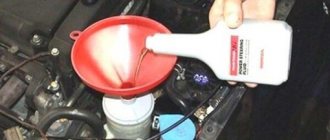The use of power steering in passenger cars is caused not only by the desire of designers and buyers to reduce the physical force applied to the steering wheel when turning. The hydraulic booster increases driving safety, allowing the driver, for example, to quickly turn the steering wheel in the right direction when the wheel gets into a deep rut or hole. Another plus in the direction of risk-free driving is less fatigue during long trips and ease of parking. In order for the unit to work effectively, it must be serviced in a timely manner, and one of the maintenance stages is replacing the power steering fluid. Why should you do this, why, when and how? More on this below.
How does power steering fluid work?
The composition circulating in the vehicle control system not only ensures the functioning of the entire system. Power steering fluids remove heat from parts, preventing them from overheating, and also protect against corrosion and reduce wear. For these purposes, a special substance has been developed that works normally in a wide temperature range: from minus 40 to plus 120 degrees.
Power steering design
A hydraulic unit (there are also electric units) includes several parts that are somehow connected to the fluid moving in the system. How do they function?
- Pump. A device with blades driven into rotation by the engine crankshaft through a belt drive.
- Working fluid. It is poured into a special tank and comes out from there into two channels: one leads to the pump, the second is the “return”.
- Discharge valve. It is necessary to maintain constant pressure in the system, since the engine speed is constantly changing.
- Distributor with power cylinder. They are the ones who are “engaged” in the redistribution of fluid flow when turning the steering wheel.
- Spring torsion bar. It stands at the entrance to the hydraulic booster shaft and runs inside the spool. When the steering wheel rotates, the torsion bar twists, the spool moves and opens the required channel into which the fluid flows. At the end of the torsion bar there is a gear that interacts with the steering rack.
Mild flow: how and why to change power steering fluid
Unfortunately, many people believe that the power steering fluid does not need to be changed, and it lasts for the entire life of the car. Well, if the iron horse has recently left the stall of the dealership, and the owner’s plans do not include driving it for much more than three years, then you can relax and forget about this operation. But the car has already passed “well over 100”, it is about five years old or more, and the annoying hum of the power steering pump when turning the steering wheel causes serious emotional wounds. Then many people have a question: shouldn’t we change this fluid? And if so, how to do it? It turns out it's not difficult at all. Shall we try?
What if you don’t change the power steering fluid?
The composition circulating in the structure constantly experiences temperature changes and therefore gradually loses its qualities. Metal microparticles formed as a result of natural wear and tear of control parts make their “mite” in this process. As a result, the car begins to listen poorly to the steering wheel.
The most radical result of untimely replacement of power steering fluid is jamming of the system, which can create an emergency situation.
Power steering oil requirements
- Heat resistance.
Since the oil is intended not only for lubricating mechanisms, it acts as a heat sink from heated parts and parts of the hydraulic booster. The liquid must be resistant to high temperatures up to 110⁰C, and also not lose its properties at low pressure and at temperatures down to minus 35⁰C.
Power steering oil contains additives that control the level of fluid viscosity under conditions of changing ambient temperatures. Thanks to this, at low temperatures the oil retains its properties and does not thicken, which allows you to rotate the steering wheel without extra effort.
A distinctive property of good and high-quality oil is its transparent appearance and uniform consistency. Even after the machine has been idle for a long time, additives should not precipitate and clog the oil.
Oil still has an aggressive effect on the rubber parts and mechanisms of the machine. It is worth choosing a type of fluid that has special additives with the function of a protective film, thereby reducing the wear life of rubber parts.
An undesirable phenomenon in the power steering oil tank is foaming. The appearance of bubbles can have a bad effect on the steering wheel turning mechanism, namely, the process of transferring force from the steering wheel to the turning mechanism will be difficult. So you should pay attention to this important criterion when choosing oil.
When to change power steering fluid: signs
First of all, you should rely on the instructions for a specific car model and make a replacement in accordance with the manufacturer’s recommendations. However, if specific signs appear, it is worth doing this earlier than planned if:
- the oil level has dropped below the mark on the tank;
- the steering wheel has become harder to turn and is difficult to hold in one position;
- in the engine compartment in the area where the power steering is located, sounds uncharacteristic of its operation appeared;
- drop the oil on the dipstick onto a white sheet of paper: dark color and the presence of foreign inclusions (wear particles) indicate the need to replace the composition;
- there is a burning smell from the power steering: this means that constant high-temperature exposure to the fluid has rendered it completely unusable.
Only one conclusion can be drawn here: it is necessary to replace the fluid in the power steering as soon as possible. How to do it?
Fluid replacement intervals
Having a car is not enough just to be able to drive it. It is necessary to know the replacement intervals for technical fluids. The trouble-free operation of all systems depends on this. Fresh fluid extends the life of the parts it comes into contact with.
Periodically, your car has to change the lubricant in the engine, gearbox, coolant and brake fluid.
Rules for replacing technical fluids
Each type of liquid has its own service life. Manufacturers have established certain intervals for their replacement.
The replacement procedure is not particularly difficult. Each driver can do this himself. The main thing is to know when and why to change fluids.
There are situations when the fluid needs to be replaced ahead of schedule. This can happen with engine oil, coolant or brake fluid.
Before replacing, you must purchase fresh fluid. In this case, you should know how much volume is needed. The choice should be made in accordance with the car manufacturer's recommendations.
If you do the replacement yourself, you need to prepare a container in advance where the old liquid will be drained. For work, you need to use special protective gloves to prevent liquid from getting on the skin of your hands.
All used fuel and lubricants products must be disposed of appropriately.
Power steering fluid change interval
Power steering ensures smooth and comfortable driving. For power steering to function, a sufficient volume of fluid in the system is necessary. To control its level in the engine compartment, there is a special tank with the corresponding MAX and MIN marks, or, if there are no inscriptions on the tank, then the tank cap performs the function of a measuring probe.
The normal power steering fluid level may vary depending on the specific vehicle model. During normal operation of the power steering system, there is no need to frequently add fluid, but in the event of a leak and depressurization, the fluid level may drop to a critically low level. The main signal that something is wrong with the steering system is a suddenly “heavier” steering wheel. In this case, it is necessary to check the fluid level and contact a service station to diagnose the operation of the entire steering system.
Many manufacturers claim that power steering fluid does not require replacement during the entire life of the vehicle. However, this statement is wrong. Power steering fluid, like any other technical fluid, has its own service life. Therefore, it is recommended to change the power steering fluid 1-2 times a year, depending on operating conditions. The maximum recommended interval for replacing power steering fluid is every 80 - 100 thousand km. mileage
Brake fluid change interval
A properly functioning braking system is the key to the safety of the driver and his passengers. It is necessary to monitor its serviceability regularly. For operation, brake fluid is poured into the system. Depending on the manufacturer, it may differ in composition and name. When choosing a fluid for your car, you should strictly adhere to the manufacturer’s recommendations. This applies not only to the brand, but also to the brake fluid replacement interval.
To control the brake fluid level, there is a reservoir with two marks: for minimum and maximum volume.
During normal operation of the brake system, topping up is not required. At the same time, it must be taken into account that brake fluid is hygroscopic. Over the course of a year, it can absorb 2-3% of water from the air. In this regard, corrosion will begin to appear on the inner walls of the parts over time, and the liquid itself will lose its properties. As a result, this can affect the operation of the entire braking system: braking efficiency will decrease, and the braking distance, on the contrary, will increase.
Sometimes it is not known when the brake fluid was last changed. This often happens when buying a used car. In this case, you can contact a service station, where they will check its quality using a special device and, if necessary, carry out a replacement procedure. In normal condition, brake fluid has a clear golden color.
The recommended frequency for replacing brake fluid is every 1-2 years, regardless of mileage, or after a mileage of 60,000 km (whichever comes first). You should not change the brake fluid more often, as this will not have any effect.
Coolant (antifreeze) replacement interval
Antifreeze or antifreeze is used as a coolant in cars. Less common is ordinary water, as it promotes corrosion.
The frequency of replacing the coolant may depend on the operating conditions of the vehicle. Monitoring the engine cooling fluid level is not difficult. To do this, there is an expansion tank in the engine compartment with two marks: minimum and maximum. The exact level can be monitored on a cold engine. If necessary, add coolant to the expansion tank. This has to be done more often than with other technical fluids, since the degree of evaporation of the coolant is very high.
If it is necessary to replace the antifreeze in a car, then this should be done only when the engine has cooled down sufficiently. It is strictly forbidden to open the radiator cap while it is hot.
It is not recommended to mix different types of coolants with each other.
If you are replacing the coolant yourself, then you need to choose the right type of fluid: antifreeze or antifreeze, and also check whether it is a concentrate that needs to be diluted with distilled water.
The frequency of replacing antifreeze in a car, as well as antifreeze, is every two to three years or after 60-70 thousand km. vehicle mileage.
Gearbox oil change interval
There are two main types of transmissions: manual and automatic.
The method for checking the oil level in them may differ depending on the design. Sometimes this requires taking the car to a service station. The service life of transmission oil in different cars is from 20 to 60,000 km. The manufacturer often indicates the timing of oil changes on the packaging.
The timing of the transmission oil change may be influenced by the operating conditions of the vehicle. If the gearbox overheats frequently, oxidative processes in the oil begin to activate. In this regard, tar deposits are formed. The lubricant begins to lose its anti-wear and extreme pressure properties.
External factors can also affect the rate of oil wear. If dust or water gets inside the unit, it will lose its lubricating properties.
Gearbox oil can be mineral or synthetic.
A more precise frequency of changing transmission oil depends on the design of the gearbox and the type of oil.
Synthetic oil for automatic transmission / manual transmission
- Under normal operating conditions, 60,000 km or every 2 years.
- Under severe operating conditions, 30,000 km or every year.
Mineral oil for manual transmission
- Normal conditions - 50,000 km / 2 years.
- Severe conditions - 25,000 km / 1 year.
Robotic gearboxes and CVTs deserve special attention. The required oil level in these units is extremely important for their normal operation.
In such boxes it is recommended to change the oil every 25,000 - 30,000 km. Many car owners adhere to this recommendation, regardless of the operating conditions of the car. It is especially important to observe this interval for older cars.
It is advisable to change the oil in the automatic transmission and variator at a service station. If you simply drain the lubricant from the unit, some of it will remain in the torque converter, pump and valve body. When pouring, fresh oil will mix with old oil and lose some of its properties.
Service stations often have special equipment for pumping oil out of the cavities of the unit.
Compliance with replacement intervals for technical fluids is vital for the normal functioning of vehicle components. Neglecting this will inevitably lead to unpleasant consequences.
Choosing oil for power steering
In the international classification, any product for power steering is labeled as PSF. The liquid can have one of three colors:
- red;
- green;
- yellow.
This was done specifically to prevent mixing of formulations containing additives that do not tolerate each other. That is: green liquid cannot be combined with any others. Yellow oil can only be mixed with red oil. The best option (it’s better not to experiment!) is to fill in the same liquid recommended by the manufacturer to prevent the formation of clots and lumps, which will lead to dismantling, disassembling and cleaning the power steering. Here are some guidelines:
- for cars with automatic transmission - only red fluid;
- for cars with “mechanics” - only green oil;
- for both types of boxes - a yellow product.
Another point: the car manufacturer may recommend several types of fluids. It is important to follow the rule that you should not mix mineral oil with synthetic oil. Whatever liquid the system worked on previously should be filled in.
Important: both synthetics and mineral water can be red. These compounds (for example, Dexron II-IV, New PSF-3) are most often used in Korean-made cars, Toyota, BMW (before 1994), Chevrolet. Yellow liquids are more often poured into Mercedes, green (both synthetic and mineral) into VW and French cars (except Renault Duster).
Varieties
Drivers most often determine the type by color, although in reality the composition of the oils, viscosity index, base and additives used are important. Determine by color:
- Reds. The so-called Dexrons, classified as oils intended for automatic transmissions. Their use is also allowed for power steering on some vehicles;
- Yellow. In most cases, these are used on Mercedes cars;
- Green. VAG Concert prefers to use; it is also used on Peugeot, Citroens and other cars.
It is important not to mix compounds of mineral and synthetic origin under any circumstances. Which one is better is a hypothetical question. Mineral compounds have a better effect on the life of rubber parts, while synthetic ones have better performance characteristics. To determine which one is best for your car, use your owner's manual or expert advice.
How to completely change the power steering oil
You can change the fluid in Moscow by contacting any technical center, but you can do it yourself. Before pouring fresh composition, carry out preparatory work and prepare the following tools and devices:
- large disposable medical syringe or rubber bulb;
- 10mm wrench (preferably a socket wrench);
- a suitable container (you can use a regular one and a half liter plastic bottle);
- pliers;
- flexible hose with a diameter of 6-8 mm;
- jack and rags.
You will also need an assistant. Next, place the front of the car on a jack to facilitate the operation of the power steering and free rotation of the steering wheel. Cover nearby engine parts with a rag, including the power steering pump drive belt, to prevent oil from accidentally getting on them. Further:
- attach the hose to the syringe, unscrew the tank cap and lower the “structure” into it to remove the old liquid;
- remove the clamps and disconnect the hoses to remove the tank;
- pour out the remaining liquid and rinse the container and pipes;
- To ensure that the oil flows out of the system completely and quickly, ask an assistant to turn the steering wheel in both directions (there is no need to start the engine);
- lift the suction hose connected to the pump; you also need to add liquid into the pipe through the funnel - at the same time turn the steering wheel until clean and fresh oil appears from the return line;
- rinse the tank and install it in place, attaching the hoses and tightening the clamps;
- add fluid to the maximum level mark;
- turn the steering wheel, start the car and repeat the operation;
- when air bubbles appear in the tank, turn the steering wheel until they disappear;
- Turn off the engine and again add fluid to the maximum level.
Partial fluid change
Everything is much simpler here. At the first stage, perform the same operations: put the car on jacks to raise the front end and cover the nearby “territory” with rags. After:
- remove the old fluid with a syringe and add new fluid to the MAX level;
- start the engine and slowly turn the steering wheel in both directions until the end;
- you need to drain the oil, and if it is dirty, add it to the required level: repeat the operation until fresh fluid comes out.
Some probes have not two levels - MAX and MIN, but four: MAX COLD, MAX HOT. The first of them shows the maximum level on a hot power unit, the second - on a cooled one.
How to determine when an oil change is needed
The operation of power steering is associated with a constant increase in the temperature of its components. Because of this, the oil in it also heats up, which leads to a deterioration in its physical properties. The color changes and a burning smell appears. The result is the impossibility of performing functions.
To examine the state of a substance, follow these steps:
A good liquid should be transparent, without impurities or cloudiness. If there are foreign particles floating inside and the substance emits a distinct smell of burnt oil, it is time for replacement.
Not sure about the condition of the oil? Take a drop of new liquid from the canister and compare them.
Used and new power steering fluid
Remember: if you do not replace the substance, the power steering will begin to work worse and worse and over time may completely fail. The result will be deterioration in car control - up to complete loss.
Sometimes the power steering malfunctions and substances begin to leak out of it. If you see a leak or detect it based on indirect signs (deterioration in controllability, noise in the steering system), follow these steps:
Stop the engine and wait until it cools down.
Thoroughly dry each steering element.
Check how much fluid is in the tank, add if necessary.
Start the engine and turn the steering wheel in different directions to the maximum.
Find where the substance is leaking from and eliminate the defect.
Regularity of power steering oil changes
There is a planned replacement of power steering fluid and early or emergency replacement. The regular filling of a new composition into the system is carried out once every 1-2 years (after 25-30 thousand km), which is related to the make of the car, its model and year of manufacture. The operating conditions also matter: the harsher they are (constant driving in the city or in very dusty conditions, etc.), the sooner the composition needs to be replaced.
The fluid in the hydraulic booster is replaced ahead of schedule in the event of a breakdown of parts of the steering mechanism, which includes a rack, rods, gears and other parts and components. It is worth replacing if the system is depressurized and power steering fluid leaks out. The same must be done if power steering components are replaced due to failure: cylinder, spool, pump, pipes. The level of hydraulic fluid in the reservoir and its condition (color, presence of inclusions) are checked once every 6 months.
What is needed to change power steering fluid?
This procedure is not one of the complex technological procedures that require modern and high-quality equipment. Thanks to this, it can be done at home, and for this you will need:
The process itself takes about 15-25 minutes. If the contamination is minor, then you can get by with a partial replacement, but in most cases you need to make a complete replacement, and if the car has a lot of mileage, wash it. Also, when the power steering hums, it is not always necessary to replace it; the reason for this phenomenon may be a normal leak.
Complete replacement
Preparatory work includes hanging the front wheels of the car. This must be done, since the power steering system is pumped by turning the steering wheel to its extreme positions.
First of all, remove all power steering fluid from the reservoir, as in the case of a partial replacement. After this, disconnect the inlet and outlet pipes from the tank and lower them into a suitable container.
If the tank is very dirty, it is better to remove it and wash it. Any cleaner will do, you can use gasoline or kerosene, the main thing is to dry it before installation, or blow it out with a compressor.
Now, in order to expel the remnants of the old fluid from the circuit, we sit behind the wheel and turn it all the way in different directions. Many car owners start the engine for a few seconds. This activates the power steering pump and the fluid drains faster.
But manufacturers do not recommend starting the car with the fluid drained from the hydraulic fluid - this has a detrimental effect on the pump.
After the liquid stops flowing from the pipe coming from the pump, install the tank in place and fix the pipes.
Fill in new fluid to the max mark and go turn the steering wheel (no need to tighten the reservoir cap). As the oil decreases, add it. We expel the remaining air from the system with the engine running, holding the steering wheel in extreme positions for several seconds.
Check the fluid level one last time and screw on the cap. This completes the power steering oil change.
Those who want to perform a standard replacement of power steering fluid, after the described procedures, drive several tens of kilometers and change the oil again, thereby flushing the system.











